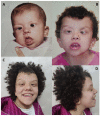The Cardiofaciocutaneous Syndrome: From Genetics to Prognostic-Therapeutic Implications
- PMID: 38136934
- PMCID: PMC10742720
- DOI: 10.3390/genes14122111
The Cardiofaciocutaneous Syndrome: From Genetics to Prognostic-Therapeutic Implications
Abstract
Cardiofaciocutaneous (CFC) syndrome is one of the rarest RASopathies characterized by multiple congenital ectodermal, cardiac and craniofacial abnormalities with a mild to severe ocular, gastrointestinal and neurological involvement. It is an autosomal dominant syndrome, with complete penetrance, caused by heterozygous pathogenic variants in the genes BRAF, MAP2K1/MEK1, MAP2K2/MEK2, KRAS or, rarely, YWHAZ, all part of the RAS-MAPK pathway. This pathway is a signal transduction cascade that plays a crucial role in normal cellular processes such as cell growth, proliferation, differentiation, survival, metabolism and migration. CFC syndrome overlaps with Noonan syndrome, Costello syndrome, neurofibromatosis type 1 and Legius syndrome, therefore making the diagnosis challenging. Neurological involvement in CFC is more severe than in other RASopathies. Phenotypic variability in CFC patients is related to the specific gene affected, without a recognized genotype-phenotype correlation for distinct pathogenic variants. Currently, there is no specific treatment for CFC syndrome. Encouraging zebrafish model system studies suggested that, in the future, MEK inhibitors could be a suitable treatment of progressive phenotypes of CFC in children. A multidisciplinary care is necessary for appropriate medical management.
Keywords: BRAF mutation; CFC; Cardiofaciocutaneous syndrome; KRAS mutation; MEK1 mutation; MEK2 mutation; RASopathies; hypertrophic cardiomyopathy; neurodevelopment.
Conflict of interest statement
The authors declare no conflict of interest.
Figures



References
-
- Abe Y., Aoki Y., Kuriyama S., Kawame H., Okamoto N., Kurosawa K., Ohashi H., Mizuno S., Ogata T., Kure S., et al. Prevalence and clinical features of Costello syndrome and cardio-facio-cutaneous syndrome in Japan: Findings from a nationwide epidemiological survey. Am. J. Med. Genet. Part A. 2012;158:1083–1094. doi: 10.1002/ajmg.a.35292. - DOI - PubMed
-
- Rauen K.A. Cardiofaciocutaneous Syndrome. In: Adam M.P., Mirzaa G.M., Pagon R.A., Wallace S.E., Bean L.J., Gripp K.W., Amemiya A., editors. GeneReviews®. University of Washington; Seattle, WA, USA: 1993. - PubMed
Publication types
MeSH terms
Supplementary concepts
LinkOut - more resources
Full Text Sources
Medical
Research Materials
Miscellaneous

